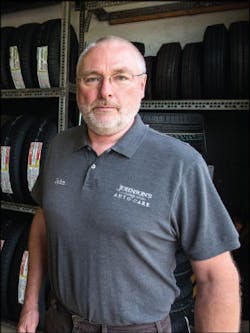John Johnson looked at the reports over and over again. Each time, he could check off almost every number on the page in front of him. Average repair order (ARO), hours per job, staff efficiency—his shop was hitting or exceeding nearly every benchmark it had set. To top it off, his recent advertising push was paying off to the tune of 50 new customers every month.
This should’ve been a time of substantial growth, Johnson says, but, somehow, car count was actually going down, along with the shop’s sales numbers.
“It didn’t make any sense,” Johnson says. “If you’re getting in new customers regularly, and you’re getting out of each vehicle what you need to, you should be increasing sales, and increasing car count. There was something missing there.”
It took a late-night epiphany—or, really, a sleep-deprived hunch—for Johnson to get to the answer to the jumbled equation: All those first-time customers he was bringing in were sent back out the door as last-time customers.
“People weren’t coming back, and I mean they weren’t coming back—it’s not like our repairs were bad and people were back in complaining. That wasn’t happening,” he says. “The only place to look was the front counter.”
The Background
Early on, things were “simple” for Johnson when he founded Johnson’s Auto Care in Conway, N.H. The small, three-person shop was a breeze for the 21-year-old. Combined with tire sales and his specialization in transmissions, Johnson worked quickly to gain substantial market share in the small town, quickly getting annual sales above the $500,000 mark.
And that stayed steady for years—decades even. Johnson, now 58, says it was right around 2000 that he realized he needed to shake things up. The transmission-only work was becoming less and less frequent, and he saw an opportunity in a changing marketplace to take advantage of the shop’s stellar reputation and go after a larger slice of the customer base. He started working with a business coach that year, and he left the back of the shop to take on a more managerial (true ownership) role in the business.
He hired a service advisor and an additional technician. He put a new effort into his marketing, trying to convey “the personality” of his business to customers, selling them on their trustworthy, local, small-town culture.
“Everything in our marketing, it all has the same look, feel and message,” says Johnson, noting that his shop is a clear representation of the area that includes just 30,000 people in a 15-mile radius.
The growth was steady. The shop increased sales to $575,000 after the first couple years. Then it moved above $600,000, then $700,000, before topping out at $875,000 in 2007.
The following year—seemingly out of nowhere—sales dropped to $750,000.
The Problem
Cue the small lamp shining dim light over a pile of papers. Zoom in on Johnson sitting at the desk in his home, beer in hand, grimace on his face, trying to make sense of his business’s sudden about-face.
“I had just gotten back from a [20 Group] meeting, and I was literally sitting there hoping that something would jump out at me,” he says.
At first, he was worried that the demographics he targeted with his marketing were inaccurate. But his ARO and percentage of work sold confirmed that new customers we comfortable with his shop and its pricing. Plus, the new customer demographics mirrored those of his longtime, loyal clients.
Then, it hit him: The shop was almost spot-on consistent with 50 new customers each month, yet the shop’s work mix of new customer work had risen by 4 percent (to roughly 24 percent overall). Without a growth in sales, that would mean his “regular client base” had decreased by 4 percent. But those new customers should’ve been regularly increasing that number, Johnson says.
That is, if they were actually coming back to the shop.
Johnson started looking at records of his new customers from a year prior and what they had spent on subsequent visits. More often than not, the answer was zero.
“All these people we were bringing in and selling on that initial work weren’t becoming loyal customers,” he says.
As they weren’t getting any comeback issues on repairs, Johnson knew where the problem was: his service advisor.
The Solution
1 It’s almost natural to overlook things when you’re in growth mode, Johnson says.
“Everything was nice and easy for a while, and we were really happy with it,” he says. “Once things change, it kind of wakes you up.”
EXPERT ADVICE
Maylan Newton,
president, Educational Seminars Institute
1 Set and Manage Proper Expectations
You need to establish minimum expectations and goals. There needs to be certain benchmarks for performance, and we also have to give expectations and procedures for how to actually handle the customers. Then, we have to regularly track the progress. We have our clients fill out a form each week, saying this is where we’re at and this is where we are toward reaching our goal. If you have expectations set, and you have a regular way of tracking those expectations, this shop owner would’ve caught this earlier in the process.
2 Identify the Problem
One great way to work with your staff is to use tracking numbers in your marketing and advertising that can allow you to record the phone calls. Then, as an owner or manager, listen to those every week, and have the service advisors do the same. Then talk about what worked and didn’t work. You can help head off a lot of these problems that otherwise would be building. Then, you need to coach them into identifying what they need to do different or better.
3 Always Be Recruiting
When you’re having personnel issues and you’ve had conversations with them, then you need to be looking for improvement. If it’s taken a couple conversations, and the improvement isn’t there, it’s better to cut ties quickly. It might sound cold or callous, but you always need to be thinking of replacing your weakest link. In saying that, we need to always be recruiting year-round. You don’t want to be hiring because you need someone. I want to always have people in the hopper that can jump right in.
His service advisor, for the eight years he’d worked at the shop, had always hit every benchmark Johnson wanted him to. He helped sell the work found on vehicles, he kept ARO high, he kept the techs busy, and Johnson says he was enjoyable to be around.
But where the minimum expectations stopped, the service advisor’s effort did as well.
“He never went out of his way for customers,” Johnson explains. “If we had a full shop, and someone came in at 3:30 [p.m.], he didn’t want the hassle of doing more work and would turn people away.”
The advisor was on a bonus-pay system, and would essentially only focus on the things that contributed to his paycheck; customers were a second thought.
Johnson had been so focused on workflow, marketing and overall operations, he hadn’t looked past the numbers that reported the advisor’s work. Now, he needed to make a drastic change.
“It was a personality issue,” Johnson says. “We needed someone at the front that would be eager to help people.”
2 At the time, Johnson had a young technician who was “the epitome of a people person,” and was regularly going out of his way to help customers in any way he could. Johnson started putting the tech at the front counter part-time, hoping to push the advisor to improve.
Instead, the service advisor simply stood back and let the young tech do his work for him. Johnson decided enough was enough. He sat the service advisor down and let him go, and he trained the tech to take his place full time.
The Aftermath
These numbers were a little more to Johnson’s liking: Sales reached an all-time high in the first year after the front-desk change. By 2012, the shop was pulling in $1.2 million in sales.
Johnson still gets roughly 50 new customers each month, but with the steadily increasing customer base, his shop barely hovers around the 20 percent mark for new-customer work.
“The young guy we put at the counter is just great,” Johnson says. “He has the right fit for that position.”
3 It, evidently, was a hiring mistake that led to the former service advisor’s struggles, Johnson says. He was fortunate to have someone in-house to take over that role, and it made him rethink the way he has his front office operate.
“We want our service advisor to be a true people person, someone who is there for the customer—that’s the role,” he says. “So, we wanted to take away the obstacles that get in their way.”
Paperwork, computer entry, cashing out jobs—those can take the advisor away from customers on a busy day. So, Johnson hired an additional front counter worker to act as a greeter/cashier.
With the service advisor more freed up, he can now concentrate on the customers in the shop, more thoroughly explaining repairs and making sure he is in regular contact with them throughout the repair process. The extra attention paid to the customers is adding up, Johnson says.
Johnson now regularly monitors the customer retention. The goal is to have a “new customer” spend equal to their initial ticket price in the 12 months following that first visit.
The Takeaway
The human resources lessons were obvious, Johnson says, but one of the largest things he learned from his experience is the importance of fully understanding what makes your shop grow.
Marketing and advertising are key to getting customers in contact with your shop. Your operations—everything from technician skill to, yes, friendliness of your advisor—are what keep people satisfied and coming back.
“It can all be measured; we have numbers to track everything,” he says, “but those numbers need to be telling you something. You need to pay attention to the patterns and really understand what’s going on in your shop. That’s the only way you can keep things consistent and moving forward.”
About the Author

Bryce Evans
Bryce Evans is the vice president of content at 10 Missions Media, overseeing an award-winning team that produces FenderBender, Ratchet+Wrench and NOLN.
